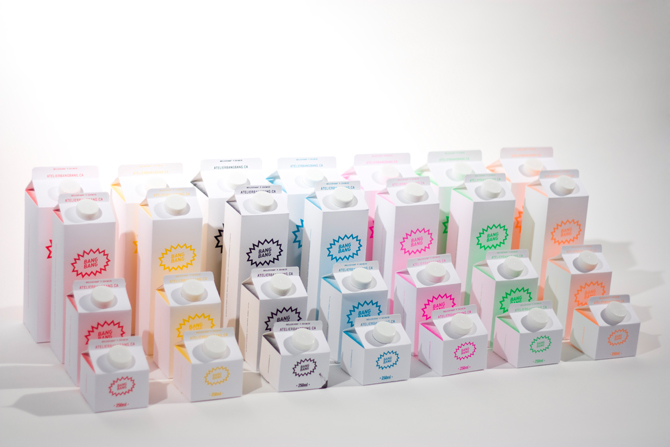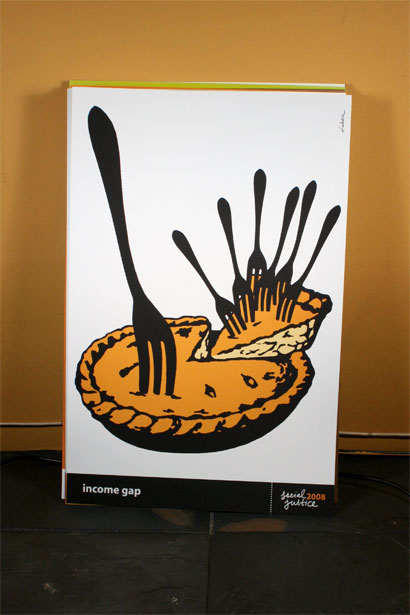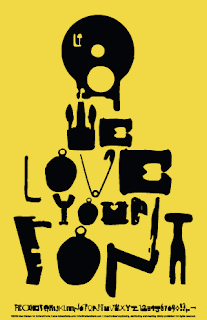Identify 5 examples of Graphic Design appearing in different contexts:
1. Banksy – Ronald McDonald and Mickey Mouse. The concept of this visual poster is rally strong and effective. Though there are no words used in this piece, but the visuals say what it needs to be said. Two largest company icons dragging the child along their sides who looks in pain.
2. Saul Bass poster 'Anatomy of murder'.Simple, clever and creative. It all that needs t be said. Represents the movie really well.
3.Danny Sangra. Analyses the gender and uses drawing to give that special 'touch' to the picture.
 4. Ramona Todoca - beyond the edge. A 3D typographical sculptural piece.
4. Ramona Todoca - beyond the edge. A 3D typographical sculptural piece.
Identify 5 examples of Graphic Design performing different functions:
1. Identity
Deskidea is
an office supplies e-commerce business with one main aim: to get a major
sense of simplicity from the very first purchase from their website
until the receipt of the material in your office.
The brand identity was designed to boost this simplicity value and
the graphic solution came from the name itself, Deskidea. The idea was
to convey its value using basic office objects, with the pencil taking
lead role.
The different corporate applications are based on the pencil as a symbol, operating by itself or embedded within the identity.
2. Book. author: unknown
3. Re-branding to prove a point or uncover the truth.
4. To promote. The Decemberists London Concert Poster by Mike King
5. To entertain. This is an ongoing personal project. Created with Luxology Modo and based on my characters. By Teodoru Badu.
Identify 5 examples of Graphic Design delivering different types of messages:
1. Educational. Brockhaus Horizonte Encyclopedia Infographics
2. Informational
3. Political. Shepard Fairey. Obama campaign.
4 Questioning the audience. by Adbusters.
5. Social problems.
For as long as I can remember, at least ten years back, I have admired
the work of Luba Lukova, with its restrained one- and two-color palettes
and poignantly simple illustrations. I have always seen the work in
books or online, small and only fractionally representative of the
impact its bigger brethren have. With
Social Justice 2008,
a 21.5-inch by 14.5-inch portfolio of twelve, unbound posters by
Lukova, published by Clay & Gold Editions, her work is given a
second life — both as artifacts that once already existed and by
assigning each with a concept, notion or social issue that is intimately
tied with our current state of affairs.
Identify 5 examples of Graphic Design produced using different media:
1. Wood. by Sophie Wilson.
2.Paper
New book designed by DED. 'VITAL' - A collection of essays, memories and
photographs that celebrate international Chinese live artists focusing
on the Vital Festivals organised by Chinese Arts Centre. A lovely
multi-stocked book to be viewed as a scrap-book on Chinese Live Art.
7 different paper stocks, special inks and a do-it-yourself diecut cover make this a beautiful piece of print.
3.T-shirt
We recently launched a project called "This is What Matters to Me", a
cause-inspired collaboration between 9 designers from around the globe,
each
supporting a cause/organization personally significant to them.
The aim of the project was to bring focus to a few lesser known causes
via limited edition prints. Each shirt is limited to an edition of 150.
Contributors include Non-Format, No Pattern, Mario Hugo, Keetra
Dean-Dixon, Emil Kozak, Gary Fernandez, Grandpeople, Marta Cerda
Alimbau, and myself.
4. Wall paper
Be the envy of all your friends with these tall silver birch trees wall
stickers, designed to fill a whole wall. They come individually so you
can spread them out on a wall or even all around the house! The trees
stretch from floor to ceiling and are ideal for spaces such as living
rooms, bedrooms and kitchens, hall ways and even outside. The pack
contains 6x silver birch trees, each one measuring 240cm high and
together are 3.5 m wide and 5x birds measuring roughly 28cm x 20cm.
These Wall stickers are really popular and are a great way to bring a quirky focal point to the room.
All Vinyl Impression wall decals/stickers are precision cut from our
high grade low-tac removable self adhesive vinyl in the colour and
direction of your choice. Supplied with detailed fitting instructions
and pre-applied application tape to ensure transfer is made in no time,
correctly and with ease.
[CUSTOM SIZE]
If you need a smaller or larger size then just send us a convo for pricing and we will be happy to list it for you.
[REVERSED IMAGE]
The decals can be reversed/mirrored. Just mention it in the message to seller section of checkout. Read Less

5. Web-design, mobile apps
A redesign of the standard iPhone app icons. In different sizes so you
can see more information like messages right from the home screen.
In a retro pixel '8-bit' style
Identify 5 examples of Graphic Design produced at different scales:
1. A0 (1682 x 1189 mm) Poster by Peter Tarka
2.
2. Wall paper by Bruce Mau.
General Electric (GE) is a global
infrastructure, finance and media company serving customers in more than 100
countries with nearly 300,000 employees, taking on today’s toughest challenges.
From everyday light bulbs to fuel cell technology, to cleaner, more efficient
jet engines, GE has continually shaped our world with groundbreaking
innovations for over 130 years. GE
(NYSE: GE) works on things that matter. The best people and the best
technologies taking on the toughest challenges. Finding solutions in energy,
health and home, transportation and finance. Building, powering, moving and
curing the world. Not just imagining. Doing. GE works.
BMD is
collaborating with GE to bring the GE Works brand platform to life in GE’s
corporate, research and manufacturing facilities. Focusing on high-impact
opportunities, we are developing environmental expressions of the brand that
are integrated with the existing architectures and functions of each facility,
connecting employees and visitors with the core of the four pillars.
We have
created a system that is flexible in scale, budget and content., featuring 3D
crops of the famous GE monogram, large-scale wall graphics, sculptural
elements, digital displays and pillar messaging.
Starting
with the GE’s global corporate headquarters in Fairfield, CT, we have been
engaged in designing and implementing at flagship sites across the US and
around the world, and continue to work with GE on additional locations.
3. business card (49mm x 87mm) by William Branton
4. Album cover (300x250mm) by Martin Stousland
Monteé - Rendition of you
Oslo
based popgroup Monteé released their second album rendition of you in
april 2011. The idea was to create a modern version of Miles Davis
classic bitches brew, that was more maximalistic than minimalistic, but
with use of forest elements that the band had used on earlier artwork.
All the photos was illustrated, and beside the vinyl edition, the cd
version has been produced and other merchandises such as t-shirts,
totebags, backdrops etc.
Design: Christian Bielke & Martin Stousland
Illustration: Ingri HaraldsenDocumentation photo: Henrik Beck Kæmpe
5. A magazine/news-print (750 x 600 mm)


























